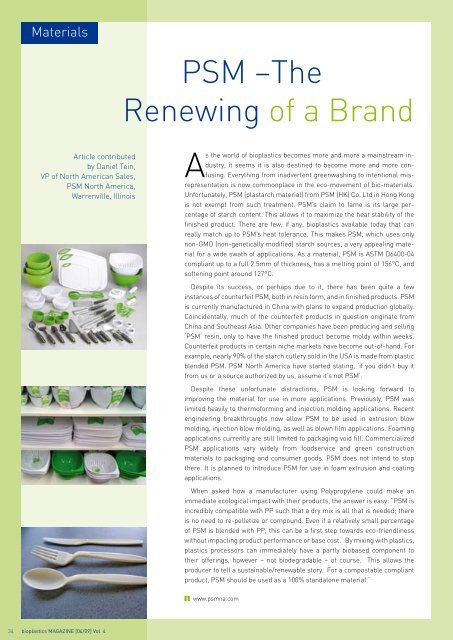bioplasticsMAGAZINE_0904
bioplasticsMAGAZINE_0904
bioplasticsMAGAZINE_0904
You also want an ePaper? Increase the reach of your titles
YUMPU automatically turns print PDFs into web optimized ePapers that Google loves.
Materials<br />
PSM –The<br />
Renewing of a Brand<br />
Article contributed<br />
by Daniel Tein,<br />
VP of North American Sales,<br />
PSM North America,<br />
Warrenville, Illinois<br />
As the world of bioplastics becomes more and more a mainstream industry,<br />
it seems it is also destined to become more and more confusing.<br />
Everything from inadvertent greenwashing to intentional misrepresentation<br />
is now commonplace in the eco-movement of bio-materials.<br />
Unfortunately, PSM (plastarch material) from PSM (HK) Co. Ltd in Hong Kong<br />
is not exempt from such treatment. PSM’s claim to fame is its large percentage<br />
of starch content. This allows it to maximize the heat stability of the<br />
finished product. There are few, if any, bioplastics available today that can<br />
really match up to PSM’s heat tolerance. This makes PSM, which uses only<br />
non-GMO (non-genetically modified) starch sources, a very appealing material<br />
for a wide swath of applications. As a material, PSM is ASTM D6400-04<br />
compliant up to a full 2.5mm of thickness, has a melting point of 156°C, and<br />
softening point around 127°C.<br />
Despite its success, or perhaps due to it, there has been quite a few<br />
instances of counterfeit PSM, both in resin form, and in finished products. PSM<br />
is currently manufactured in China with plans to expand production globally.<br />
Coincidentally, much of the counterfeit products in question originate from<br />
China and Southeast Asia. Other companies have been producing and selling<br />
‘PSM‘ resin, only to have the finished product become moldy within weeks.<br />
Counterfeit products in certain niche markets have become out-of-hand. For<br />
example, nearly 90% of the starch cutlery sold in the USA is made from plastic<br />
blended PSM. PSM North America have started stating, ‘if you didn’t buy it<br />
from us or a source authorized by us, assume it’s not PSM’.<br />
Despite these unfortunate distractions, PSM is looking forward to<br />
improving the material for use in more applications. Previously, PSM was<br />
limited heavily to thermoforming and injection molding applications. Recent<br />
engineering breakthroughs now allow PSM to be used in extrusion blow<br />
molding, injection blow molding, as well as blown film applications. Foaming<br />
applications currently are still limited to packaging void fill. Commercialized<br />
PSM applications vary widely from foodservice and green construction<br />
materials to packaging and consumer goods. PSM does not intend to stop<br />
there. It is planned to introduce PSM for use in foam extrusion and coating<br />
applications.<br />
When asked how a manufacturer using Polypropylene could make an<br />
immediate ecological impact with their products, the answer is easy: “PSM is<br />
incredibly compatible with PP such that a dry mix is all that is needed; there<br />
is no need to re-pelletize or compound. Even if a relatively small percentage<br />
of PSM is blended with PP, this can be a first step towards eco-friendliness<br />
without impacting product performance or base cost. By mixing with plastics,<br />
plastics processors can immediately have a partly biobased component to<br />
their offerings, however – not biodegradable – of course. This allows the<br />
producer to tell a sustainable/renewable story. For a compostable compliant<br />
product, PSM should be used as a 100% standalone material.”<br />
www.psmna.com<br />
34 bioplastics MAGAZINE [04/09] Vol. 4


















